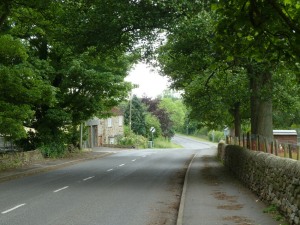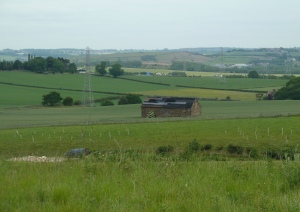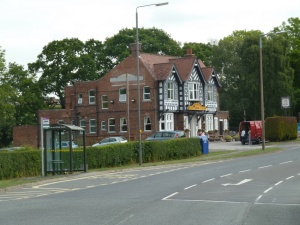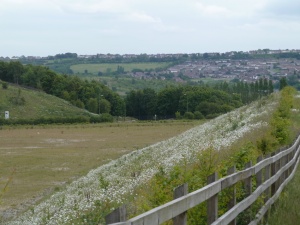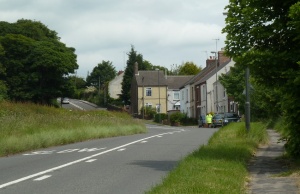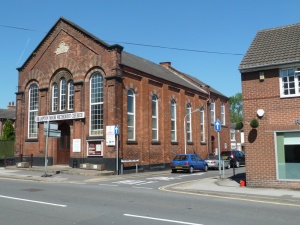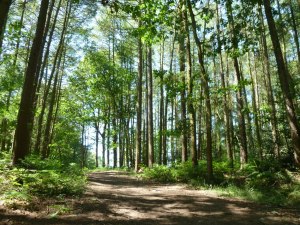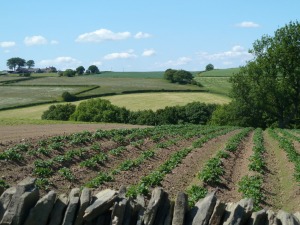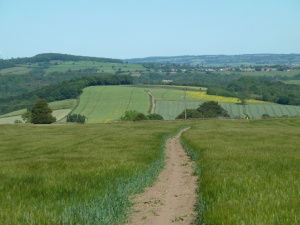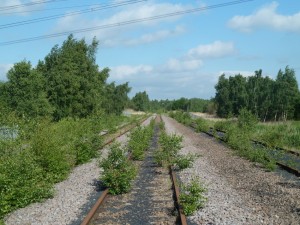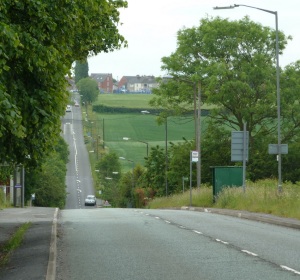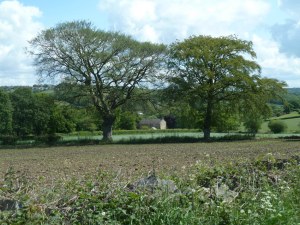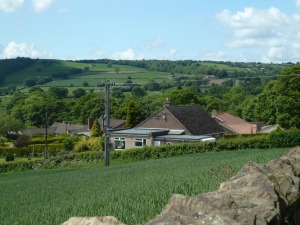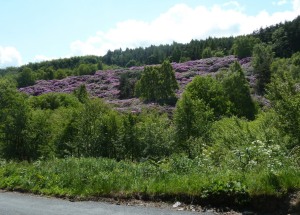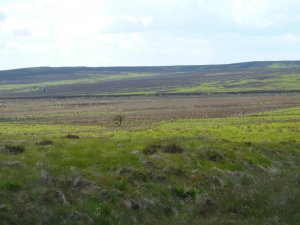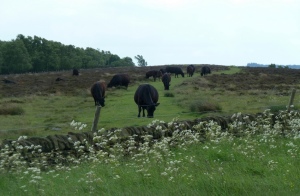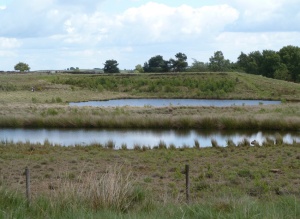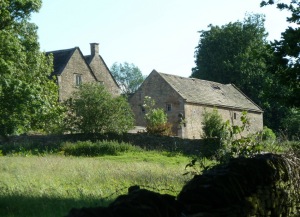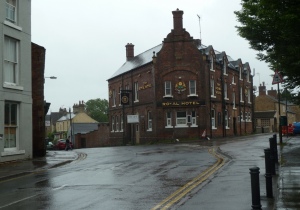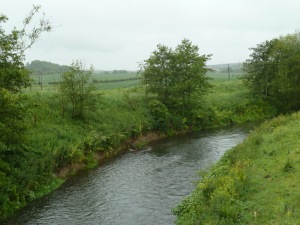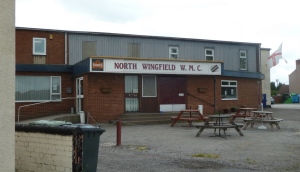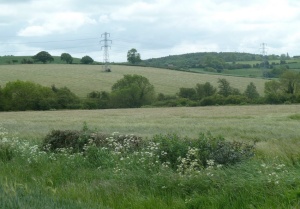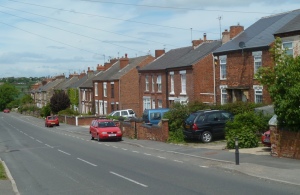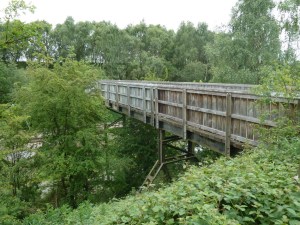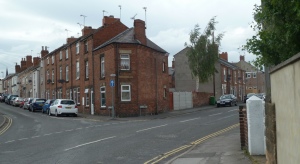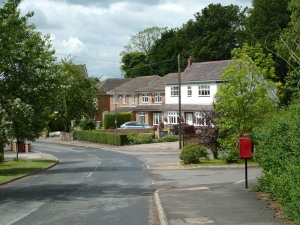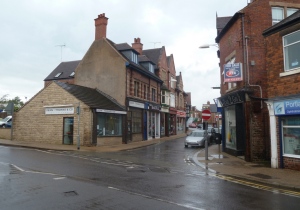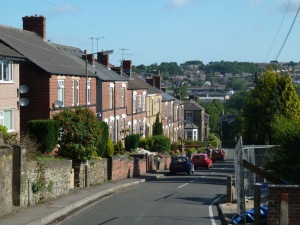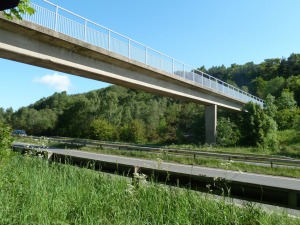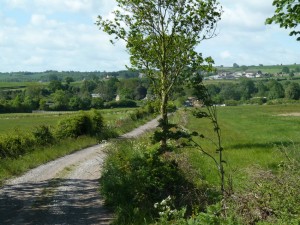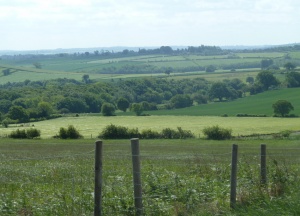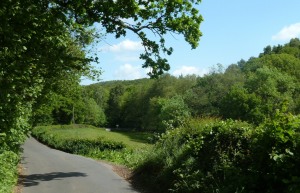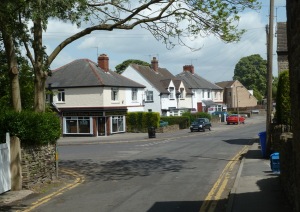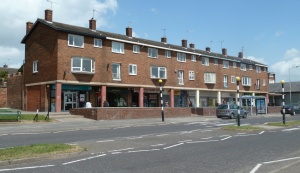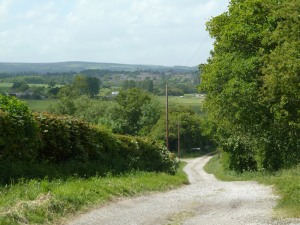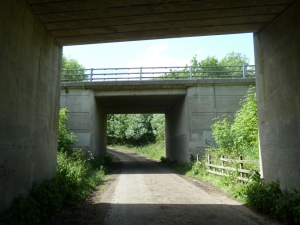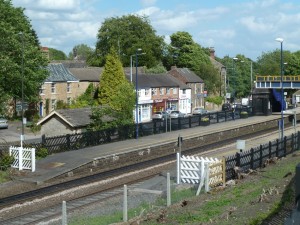2011 Rother walks – day 10 – Heath, Sutton Scarsdale, Shuttlewood
Date – Mon 6 June. Start – Stockley trail, lane between Palterton and and Sutton Scarsdale. Distance – 17.5 miles.
This was a double loop shaped route that I in fact started from home in Carr Vale, Bolsover. Of course the routes could be started anywhere to suit parking or transport requirements. I have no fixed ideas about clockwise or anti-clockwise for “circular” walks, and tended to make up my mind the day before without too much thought about which way, but trying to take into account some aspects of the route and how it appealed. This time I wanted to do a long outer loop first to leave a shorter one for the end of the day.
The parking spot at the head is just outside the squares being covered today, which was included in day 1, but there is a shortage of footpaths around Deepdale Farm. The routes coincided but did not overlap, and I took the first path bearing slightly right towards Heath. This follows on well from an observation from the previous day, the path being on a direct route between Bolsover church and Heath church. A footbridge crosses the Doe Lea and then huge open fields belonging to Deepdale Farm. (RW 10.1 – SK 4568 – Path near Deepdale Farm).
If it was not for the motorway, this would simply be quiet farming countryside. But the motorway makes its presence felt with the constant noise of traffic carrying a long distance. The motorway cuts right through the planned walking area, and I was thankful to discover that there are sufficient bridges to enable crossing points for routes to easily visit all the gridsquares without affecting route planning. The path runs close to the motorway for a short way before heading directly towards the church at Heath. (RW 10.2 – SK 4567 – Path towards Heath).
The fields here were mainly of oil-seed rape which had been such a vivid yellow a few short weeks before. The plants are quite vigorous and tend to outgrow any space provided for a path, even if it seemed quite wide originally. Always be prepared – even if it is not actually raining, you can get soaked up to the chest if it has been wet recently. This was not a problem encountered today, but even so it was a long stretch through the tall crop. The subject will crop up again later in this report…… Another major road, the A617 dual carriageway to Chesterfield, was negotiated via bridge, this time over rather than under. The church was a pleasant spot for a snack break. The route continued along the old Chesterfield road, glad that it does not still carry all the traffic that now uses the A617. (RW 10.3 – SK 4467 – Old Mansfield Road, Heath).
The first right turn, Shire Lane towards Sutton Scarsdale, took me back over the modern main road. (RW 10.4 – SK 4367 – High House Farm from Shire Lane).
At a corner near the next farm on the left, a path leaves past the farm buildings. Beyond the route was rather unclear, and the exit onto the track to Rock lane is not clear – the 1:25,000 map would have helped with the field patterns displayed. The walking was straightforward after that, following Rock Lane to Sutton Scarsdale, with occasional distant views through the trees. (RW 10.5 – SK 4368 – Rock Lane to Sutton Scarsdale).
There followed one of the longest stretches of road walking of the entire series. This was due to a lack of linked up footpaths through both the local countryside and the former industrial areas. One thing I did notice though, was that the rest of this walk was notable for how much of the route was often in view. (RW 10.6 – SK 4369 – View from Sutton Lane).
The lane descends through open farmland and then the landscape gradually changes. There were large opencast workings on Duckmanton Moor in which are now being landscaped, although still at an earlier stage than some other places nearby. The lane passes under a former railway bridge. (RW 10.7 – SK 4370 – Former railway bridge, Sutton Lane).
The most noteworthy feature of the area is the full scale removal of a complete village. Arkwright Town used to be south of the A632, but suffered from long term emissions of methane gas from the nearby colliery which closed in1988. The new village was completed in 1995 and most signs of the original village have disappeared. (RW 10.8 – SK 4270 – Arkwright Town).
The new village makes an impression when the background story is known of the upheaval of the whole community. It is by-passed, with no through routes other than the loop off the A619, so easily overlooked. I walked the loop wondering what it must be like for a complete community to change in such a dramatic fashion. The main road to Bolosover dips and then rises to skirt the village of Duckmanton. (RW 10.9 – SK 4371 – Arkwright Arms).
Beyond Duckmanton the road crosses the motorway. It was only recently that a junction was provided a little further north, which is of great benefit to Boslover and the locality. It is hoped that a lot of businesses will be attracted to locate at sites being developed on former industrial areas around Markham Lane. Once across the bridge a footpath provides a view hidden from drivers by high hedges. It shows a significant embankment overlooking the edge of the new business area. (RW 10.10 – SK 4471 – Embankment by Chesterfield Road).
The bank, covered with ox-eye daisies in flower, was an unexpected sight. Beyond the roundabout, the road onwards to Shuttlewood passes through the extensive site of the former Coalite works, a heavy industrial area with much clearance still to be done. One corner has been opened up as a household waste disposal site. Even though spacious and grander than any other such site I have seen, it still looks lost in the scale of the area. Soon some of the old industrial and office buildings can be seen, and the old railway line past the site is crossed. It all looks forlorn and rather forbidding, set down in the Doe Lea valley with the river flowing through. (RW 10.11 – SK 4571 – Part of the former Coalite works site).
The scale of the work still to be done to clear and clean the site is obvious. The old office buildings near the road are a depressing sight. Not far beyond are the first outlying houses of Shuttlewood, which must have suffered enormously from the smoke and grime of the industry. At least the area has a cleaner atmosphere than it did. (RW 10.12 – SK 4672 – Chesterfield Road towards Shuttlewood).
The road continues to climb steadily towards the village.
2011 Rother Walks – day 8 – Duckmanton, Stanfree, Staveley
Date of walk – Thu 2 June. Start – Duckmanton village. Distance – 17.1 miles.
Duckmanton, from some places to the west, looks like a fairly typical countryside village, up on a low hill. It is however far from typical in the amount of industrial activity, past and present, in the vicinity. There are former coal mining areas on almost every side, and an open cast mining area to the north has added more recent marks to the landscape. However, being within the area for the walks, it was now time for one of the more unusual walks on the agenda. I was unsure when setting out whether one of the squares was going to remain unvisited due to poor access options.
Almost immediately a diversion was necessary. The path shown heading directly north to Poolsbrook through the open cast mining land was diverted to the west, the path only discovered after wandering around a rather forlorn looking children’s recreation ground. The path took me into the edges of two squares planned for later in the day before curving east and entering Poolsbrook, as expected, from the south. Poolsbrook is a quiet place with any through traffic skirting the edge of the village. Despite warning signs, the railway crossings beyond are very quiet these days, with the last train having departed long since. As the pictures show, it was another fine day. (RW 8.1 – SK 4473 – Former railway line, near Poolsbrook).
The line served a large coal depot taking coal away from several of the nearby pits. The scale of the site is still evident on the ground. Small corners are beginning to emerge as natural habitats with a mix of wetland, woodland and meadow, but still large tracts of hard core waste land. The maps venture to show a path across the area of the railway yard, but, as expected, all was not too clear on the ground. However, there were few signs of access being restricted and a way could be found keeping close to the right route. It felt a strangely remote, out of the way sort of place. One flat, low-lying area had the most prolific display of red campion I have ever seen, sadly not showing up too well in the pictures taken on the day. By now I was close to the motorway, and approaching what turned out to be one of the surprise views of the trip. This was the River Doe Lea motorway bridge….. (RW 8.2 – SK 4573 – River Doe Lea motorway bridge).
I soon realised I needed to cross on the other side of the river, and this would provide access to the uncertain square. This was duly accomplished, even though there was the feeling that not many people pass this way at present. Perhaps further clearance of the land and redevelopment will open it up once again quite soon in the future. Heavy vehicles are often operating in the area to the south. I ventured near the bank of the river, but could see no sign of the path continuing across the square, and glad I had not planned a through route. The path on this side of the motorway also was not in evidence on the ground, so I went back under the bridge and followed a wide concrete track to the next bridge, this time a footbridge / farm track bridge over the M1. A clear track looped around to Woodside Farm and then to Woodthorpe Road, through typical arable farmland for the first time on this route. Bentinck Road is a long double terrace set apart from the village of Shuttlewood. A planting scheme along the road, a project from 2004, makes it rather distinctive. (RW 8.3 – SK 4673 – Bentinck Road, Shuttlewood).
From the far end of the street, there was a view to the right across fields to the main village, but I continued straight ahead to the Clowne road, following it for a short distance to the scattered village of Stanfree. (RW 8.4 – SK 4773 – Clowne Road from Stanfree to Shuttlewood).
The road dips and rises, and there is countryside around without being especially attractive. Rising on the side lane to Oxcroft, the hillside ahead is more appealing and wider views open out behind to the west. (RW 8.5 – SK 4873 – Above the road to Stanfree from Oxcroft).
A path rises through a strip of hillside woodland to cut a corner, and another path leaves immediately towards Clowne. This is the continuation of the slopes overlooking the Doe Lea all the way from Hardwick Hall via Glapwell, Palterton and Bolsover, although less steep towards the north. The path is set back a little with occasional rather than continuous views out to the west. Nearer to Clowne the hillside is gentler still, but more open with wide views – a good place for a snack stop. I turned sharp left to follow a clear path diagonally down to the northern side of Stanfree village – the picture was taken looking back up the fields. (RW 8.6 – SK 4874 – Path to Clowne from Stanfree).
Appletree Road led back to Clowne Road, almost directly across to Bridle Road, then a path linking with Romeley Lane. (RW 8.7 – SK 4774 – Farm track to Romeley Hall Farm).
The next path was one of the most difficult to follow on the ground. I was glad of the assistance of the pleasant lady owner who directed me across the start of the route past various farm sheds. The path was important in linking squares with few alternatives for through routes for walkers. Beyond Romeley Hall Farm the path was unclear all the way to the stream before the motorway – going the other way it may have been easier to pick out the correct route. I tried to avoid disturbing crops as much as possible, but field edges led me astray north towards Romeley Wood. However, I persevered and eventually regained the clear track for the last stretch to the motorway bridge. (RW 8.8 – SK 4674 – Small valley below Romeley Wood).
West of the motorway the path was much clearer, apart from potential confusion crossing the line of an old railway. The walking was now easy and the village of Woodthorpe directly ahead across open wheat fields. (RW 8.9 – SK 4574 – Towards Woodthorpe from the east).
The miniature steeple belonged to the school, set in lovely grounds with a flower lined footpath by the edge. The attractive little church nearby is presently unused for services. The village is very close to to the A619 with motorway access, yet little through traffic, and seemed a very quiet little backwater. I continued west and along Bridle Road and then a path to Staveley. The most distinctive feature was the main building of Netherfield School, but a failed to get a picture. The view of Bridle Lane was not really typical of the route, which generally had a much more open aspect. (RW 8.10 – SK 4474 – Bridle Road near Woodthorpe).
The edge of Staveley was previously industrial, once again with an area undergoing a slow transformation into a country park with woodland and pools in the gentle valley floor of the Doe Lea. A path skirts between houses and a small industrial park to cross an imposing footbridge over the old railway, and then I headed over the new road towards the town centre. As always, there is more to any place than the impressions gained from the main route or road through. The High Street south of the church is quite attractive and free of traffic. There is also a row of particularly distinctive terraced houses. (RW 8.11 – SK 4374 – Porter Street, Staveley).
Back on the main road, there was time to take a proper look at the modern Methodist church, built to replace the former building sacrificed to a road widening scheme. From one limited angle it actually looks quite attractive and interesting, otherwise unappealing, at least to me. For a while it ws simply a case of continuing along or close to the A619 Chesterfield Road. (RW 8.12 – SK 4274 – Chesterfield Road, Staveley).
The older housing gradually gives way to more modern development, with a couple of local shops. (RW 8.13 – SK 4273 – Shops by the A619).
The road then descends into a leafy little valley with a brief interruption to the built up character. At the bottom is an awkward road junction with Inkersall Green Road and Troughbrook Road. This is at the corner of Ringwood Park, which despite its somewhat uninviting car park opens out as an attractive area with a lake as the highlight. (Rw 8.14 – SK 4173 – Lake, Ringwood Park).
The south was covered in water lilies, just about to break into flower. Beyond the park is a little gem of valley woodland, quite a surprise with built up areas so close at hand in all directions. Trough Brook, a small north flowing tributary of the Rother, has certainly a clear cut little valley of its own, and the wood is West Wood. Woodland, and especially woodland streams, always seem difficult to capture on camera, and the subtle differences of massed trees when on the ground are lost to a large extent. However, a woodland picture is selected for this square. The valley path is not long, but quite steep in places, with very slippery mud underfoot in wet winter conditions. This time it was dry and easy going. (RW 8.15 – SK 4172 – West Wood).
A modern housing estate abuts right on to the top of the woodland, so I was soon following the street around the southern edge of Inkersall towards the track along another of the old railway lines that are such a feature of the area. This one headed back towards Staveley. They provide easy walking, but not always enabling the area to be seen to its best advantage, as was largely the case here, with generally rather restricted views. The wide, well surfaced track is good for cycling and for heavy use, but makes for dull walking. (RW 8.16 – SK 4272 – Glimpse of Inkersall from old railway).
There was a second bite of SK 4273 before heading towards Poolsbrook Country Park. The park is obviously popular, with a busy caravan site. The landscape is also still at quite an early stage of development, and looks a bit stark in some ways – no doubt it will continue to mature. Hopefully the pylons will lose something of their dominance of the scene. There will be more to be said about the large Rother Valley Country Park near Killamarsh, a feature of the penultimate walk. The picture hopefully gives a fair representation from the caravan site service road. (RW 8.17 – SK 4373 – Poolsbrook Country Park).
At the south end of the lake I found the little path I wanted continuing up the little valley. Almost immediately you are transported into a fresh area of the park which I would suggest is already a stunning success. It must have been the most prolific flower meadow I have ever seen, with a small, more natural looking lake in the centre, framed by trees set back at just the right distance – altogether a breathtaking sight. The picture shows the dominance of the yellows, but there was a real mix, including a good number of orchids. (RW 8.18 – SK 4372 – Meadow and lake by Pools Brook).
The picture was taken from a worthwhile short diversion – the path I wanted leaves back by the lake up through the trees on the left (on the right in the picture). This linked up with a larger track to Duckmanton. (RW 8.19 – SK 4372 – Track to Duckmanton).
The views to the west are quite extensive, but I was soon back in the village, noting the smart little Methodist chapel to select as the picture for the final square. (RW 8.20 – SK 4472 – Duckmanton Methodist chapel).
2011 Rother walks – day 6 – Eckington, north Staveley, Ridgeway
Date of walk – Mon 30 May. Start – Eckington church. Distance – 16.8 miles.
Circumstances led to a later start than usual, but the bonus of having the use of the car for the trip. It was a wet morning, and ended up being the only day I set off in rain. I need hardly add that it was a bank holiday Monday. Eckington town centre had a rather deserted air with some of the shops and businesses closed for the day. (RW 6.1 – SK 4379 – Royal Hotel, Eckington).
From the hotel, I followed Southgate south, which soon led to the B6053 Staveley Lane. With Renishaw park on the left, the road is quite rural, and also provided with a pavement for a considerable distance, so it proved to be a better route than I had anticipated. (RW 6.2 – SK 4378 – B6053 Staveley Lane).
One advantage was that there was no need to fiddle around too much with maps and route checking. Progress was straightforward and there was enough of change of scene and interest to keep me going quite happily. The road took me right through the next couple of squares too, partly because of a lack of alternative through footpath routes. (RW 6.3 – SK 4377 – Continuing along Staveley Lane).
It may look gloomy, but I find a grey day quite atmospheric, and to me the pictures pick up something of that as well. Yes, sometimes the clouds close right in and make visibility so poor that photography is pointless and the surrounding terrain is wiped out from view, but that is by no means always the case on a wet day. The road eventually crosses the River Rother, with the inevitable railway line crossing at almost the same spot. (RW 6.4 – SK 4376 – River Rother from Staveley Lane).
The road continues on, but with a change of name, rising up Hawthorn Hill. This section is without a footpath so requires more care for walkers. Approaching built up areas, the path is reinstated. Apart from a few farms, the first place is Hartington, virtually a suburb of Staveley. (RW 6.5 – SK 4375 – Hartington, near Staveley).
Beyond, I carefully selected the footpath route rather than crossing the bridge over the new road, only to find that a whole section was closed. There were lots of paths, and some signs, but it was very confusing finding the right way to proceed. There was no link for walkers on to the new road, so I ended up looping into Staveley, straying into a square reserved for a later walk. However, the rain was easing almost to a stop, although the real clearance was much later. Descending from Sraveley to the new roundabout, the reason for the footpath closure was spread before me – large scale works on the local section of the Chesterfield canal, which has been disused for years. The canal is to be redeveloped, with the prospect of a marina as well, which could be a real boost for the locality. Beyond, the edge of an extensive old industrial area of the Rother valley is entered along Hall Lane. (RW 6.6 – SK 4275 – Road and railway near Staveley).
Hall Lane is another road far from suited to walkers. In the picture, a small section of new footpath can be seen alongside off to the left among young trees. This soon ends at a narrow railway bridge, and then the walker has to make use of whatever verge is available. The lane climbs gradually but persistently, passing some distance from the edge of Barrow Hill. The open fields now have the sense of being undisturbed by past industrial activity, at least in recent history. The lane changes name to Staveley Lane and in the next square the transformation from urban to rural is complete. A single cluster of farm buildings and a nearby cottage are the only ones in the square. (RW 6.7 – SK4176 – Farmland above Barrow Hill).
The twin chimneys of the Barrow Hill brick works are a local landmark. A path descending east to White Lodge means they soon disappear from view. The next square north has very little access by road or footpath, so the next picture features the corner of a field where the path nudges briefly into the required area. (RW 6.8 – SK 4177 – Field corner below Staveley Lane).
The path continues to meet Breck Lane where it turns into a track at White Lodge. The picture overlooks the farm. (RW 6.9 – SK 4276 – Overlooking White Lodge).
The next square required was north, so only a corner of the White Lodge square was visited. The path headed away from open fields towards Foxstone Wood. There is no road access into the square, just private farm tracks and access to a fishing lake in the woods. As can be seen the rain still had not completely given up. (RW 6.10 – SK 4277 – Fishing lake in Foxstone Woods).
The track through the woods was an attractive part of the route, and the edge nicely coincided with the change of square. The path continued across fields, rising slightly towards the edge of Eckington. The route looked as though it was once well established with a walled lane, but now even the footpath seems little used. (RW 6.11 – SK 4278 – Fields between Eckington and Foxstone Wood).
Eckington is another place that has much more to it than the impression of driving the main through route provides. Each place in the area develops its own character as you begin to become more familiar with them. So many places are just thought of as a drag to drive through en route to somewhere of interest and therefore dismissed. Walking around the area is opening it up in a way that I am finding worthwhile and of absorbing interest, even at the stage of just scratching the surface. (RW 6.12 – SK 4279 – High Street, Eckington).
I followed a track round the northern side of a modern estate which backs onto a fields with woodland beyond. It was encouragingly free of litter and rubbish. As I continued, rain set in once more, although not as long or as heavy as in the morning. A path skirted the school grounds and route finding became uncertain. The clear path in the picture is not shown on maps, but the route marked is barely discernible on the ground. (6.13 – SK 4179 – Path to High Bramley Wood).
Once again, it was an area lacking in route signs that seemed to be one where the farmer does not like straying walkers. I take great care to follow routes as exactly as possible, but without a 1:50,000 map with the field boundary markings, it was not always easy. It only takes markers at a few strategic points to help – in most places I had no difficulties without the more detailed mapping. Anyway, I arrived at the right point on Ford Lane, followed it briefly before risking another footpath. This was mainly clear apart from the start of the way to go round rather than through Bramleyhill Farm. (RW 6.14 – SK 4079 – Track to Bramleyhill Farm).
The farm is set on quite a steep hillside above the valley of The Moss, a tributary of the Rother which forms a deep valley and an important country corridor south of Sheffield. It is one of the few areas where I heard the cuckoo calling on these walks. The walk across the valley was delightful, as the rain really did begin to clear away properly. The near and further views were attractive and varied. (RW 6.15 – SK 4080 – The Moss valley).
The route climbed and then skirted across to the village of Ridgeway. The village lines the lane up the hillside, with an attractive craft centre as well as church, chapel and former Sunday school. (RW 6.16 – SK 4081 – Church of St John, Ridgeway).
The lane then heads past a school and up the final stretch to Highlane at almost 200m. The road was followed briefly along the ridge as far as a track down to Plumbley. The hillside was less steep than further west and the track was well made for a quick descent. (RW 6.17 – SK 4181 – View from track down to Plumbley).
Plumbley Lane, a farm track was followed short distance east before continuing down to the valley floor – a lot of ups and downs today in the interests of visiting all the map grid squares. That was a small price to pay for enjoying the varied views. (RW 6.18 – SK 4180 – Horses grazing near Plumbley).
As often happens, the valley floor and northern facing slopes have more woodland – the south facing slopes being generally more suited for crops and animals. In the next square east it was uphill once again towards Mosborough, with a final look back to the country stages of The Moss valley. (RW 6.19 – SK 4280 – Valley of The Moss).
Mosborough has a network of little streets tucked away from the main road. There was a Methodist church with an impressive church hall on the next street. Just over into the next square the church of St Mark is by the main road, which was crossed to follow School Street to Station Road. There has been a lot of modern housing development around Halfway, but largely set back from Station Road. The sun finally made its first appearance of the day.(RW 6.20 – SK 4381 – Houses set back from Station Road).
Once heading on the final stretch to Eckington along Rotherham Road, the view across the Rother valley is dominated by the Morrisons supermarket and other stores on a large site at Oxclose in the foreground. After the exertions of the day the final stretch along the road finally caused a degree of weariness to set in. I am sure some more imaginative pictures could have been taken in the early evening light if more time could have been taken to explore the immediate area in more detail, but the picture to close the loop of squares for the day is just of a road junction. (RW 6.21 – SK 4381 – Rotherham Road at Windmill Greenway).
2011 Rother walks – day 5 – Clay Cross, Wingfield, Pilsley
Date of walk – Fri 27 May. Start – centre of Clay Cross. Distance – 17.0 miles.
The next day was set fair and forecast to be quite warm, which is just how it worked out. The morning got off to a slow start, being rather dull to begin with, so the picture for the Clay Cross square will come at the end of the report. To a casual visitor, Clay Cross frankly seems a bit unattractive and depressed, not helped by the busy Derby Road running right through. However, it has interesting industrial heritage, and is slowly emerging from difficult times following the closure of many of the heavier industries. It is also right on the edge of glorious countryside to the west. At least parts of it have a degree of character and individuality. To begin with I headed north on the main road, crossing another square which would be revisited almost as briefly in the opposite corner a bit later. The walk finally seemed to get under way when leaving the road west on a footpath across to Woodland Way, Old Tupton. The houses surround an area of woodland which was a target for the route. (RW 5.1 – SK3864 – Far Tupton Wood).
This little woodland was quite a feature with some fine trees, just about large enough to lose the sense of the houses all around. Beyond Ashover Road a mix of woodland and open fields continued. (RW 5.2 – SK 3865 – Path by Carr Plantation).
The walking was quite straightforward and pleasant enough without being remotely exciting. The meadows were looking maybe a touch fresher after a little rain, but the need was still great for proper rains. I am interested in weather anyway, so coinciding with this dry spring means regular references to the subject throughout these reports. The path emerged onto Nethermoor Road, where I headed back past houses towards the A61. (RW 5.3 – SK 3866 – Nethermoor Road towards the A61).
The main road was followed again for a short distance further north. An inviting path headed right on the north side of Redleadmill Brook, soon leaving behind the sense of rush and traffic. In a semi-rural area of neat fields between villages, the winding course of the brook was a welcome contrast. (RW 5.4 – SK 3966 – Redleadmill Brook).
The route looped back to the village of Tupton, crossing Queen Victoria Road and heading along Green Lane and Wingfield Road. (RW 5.5 – SK 3965 – Residential street, Tupton).
Crossing over Station New Road, I was soon back on a tree lined path by fields on one side and school grounds on the other. A friendly horse nosed over the fence as I found a spot for a refreshment break. The low lying fields were in the Rother valley, with Wingfield church perched on the top of the far slopes. The railways in the area and their footbridges became quite a feature of parts of today’s walk. The first of these provided a view towards the Clay Cross tunnel. (RW 5.6 – SK 3964 – Railway towards Clay Cross tunnel).
The path then skirted a large industrial area formerly occupied by Clay Cross Pipe Works. The final stages of the clearance of the site for redevelopment were under way. Rather lost between this site and the railway junction, the young River Rother still runs past wooded banks. The next footbridge was almost spectacular, first crossing quite high over the river before continuing over the Alfreton line. The churchyard runs all the way down the hillside to the path by the railway. I used the road to get the views before exploring the outside of the imposing church of St Lawrence, North Wingfield. The notice board was cheery with an encouragingly evangelical tone. The picture is reserved for a street view to give an impression of the place. (RW 5.7 – SK 4064 – Station Road, North Wingfield).
The route worked its way right, up New Street, which also had good views down from the top. Here I almost missed getting a picture of the next square entirely, cutting across less of its territory than originally planned. I only just avoided missing it altogether, and this is one I certainly did not do justice to. Right at the edge of the square, North Wingfield Working Men’s Club came to the rescue as a subject for a picture. This is an area where this type of club has something of a heartland. (RW 5.8 – SK 4065 – North Wingfield Working Men’s Club).
It is on Chesterfield Road, which was followed a little way further north. The field footpath was signposted but not in evidence amongst the crop on the ground, so I did an extra loop into a square visited on day 2, but it did include seeing a pleasant lake by the Five Pits Trail, where I stopped for lunch. Back into the right square, I headed towards Williamthorpe Road. (RW 5.9 – SK 4165 – Field footpath towards North Wingfield).
Crossing over, I was soon through more suburbs into fields again. The A6175, rather like the A619, passes mainly through built up sections, which gives a bit of a false impression of the area – there are plenty of open spaces around the villages and small towns. On the other hand, there is not the sense of being able to get deep into real countryside. The fields and the little valley around Seanor farm are nevertheless quite rural. (RW 5.10 – SK 4164 – Countryside near North Wingfield).
The next place to pass through was Parkhouse Green towards Lower Pilsley, then turning right towards Danesmoor. (RW 5.11 – SK 4163 – Houses on Park House Road).
The constant swapping between road and footpath, field and housing was varied but in some ways also a bit tiring, not being used to this sort of walking. The regular changes of direction and keeping tabs of the route finding in a new area also kept me on my toes. Some of the lanes were not ideal for walkers, such as the one down to Danesmoor. On the edge of Danesmoor there was an example of some of the new business and light industrial developments that are taking place in the area – a new bakery with its hunger awakening aroma. (RW 5.12 – SK 4063 – New bakery, Danesmoor).
Beyond there was a much older industrial estate to pass through before recrossing the railway and the infant River Rother. Think barbed wire, metal, machinery and you get the picture. Once across to the other side of the valley, though, it was right back into farmland. An early cropping was taking place, and swifts had obviously come from miles around to swoop low over the ground for the freshly exposed food source of insects. They passed within feet of me, by the the largest numbers of these wonderful birds I have seen for a long time. The fields were attractively patterned, with the next village out of sight beyond the brow of the hill. (RW 5.13 – SK 4162 – Fields rising towards Pilsley).
These fields were crossed on a particular day when they were seen at their best, with the interest added by the swifts lifting this stretch to become the highlight of the day. Another square, and another neat swap from field to village. Pilsley dominates this square, and is of importance in the scheme of this walk because the source of the River Rother is just nearby in gently sloping fields above to the east. I noticed Rother Street named in honour of this just off the main street through the village. (RW 5.14 – SK 4262 – Village scene, Pilsley).
The village is quite substantial, with some modern estates added to the traditional houses, a couple of shops and chapels. Heading by Pilsley Green, I turned west along Padley Wood Lane which descends towards a farm after turning left. (RW 5.15 – SK 4161 – Padleywood Farm).
The farmland was not especially distinguished after the previous stretch, but the walking was straightforward and pleasant. Into the next square though, there was a sudden dip which turned out to be a substantial railway cutting with a remarkable wooden footbridge across. I passed through a larger section of the square later, but this was definitely the subject for the picture. (RW 5.16 – SK 4061 – Railway footbridge between Pilsley and Morton).
The unremarkable farmland resumed beyond, emphasising the highlight created by the railway. The path turned into a track and then a little lane as it approached the next village, Morton. (RW 5.17 – SK 4060 – Evershill Lane entering Morton).
Morton marked one of the less well defined watershed areas, where Rother headwaters give way to southward flowing streams. The church was surrounded by dense trees with deep shade, and I left along Higham Lane then taking a footpath towards Northedge Farm. It was around the farm that the route finding was the trickiest of the day. I kicked up a storm of barking dogs on entering the farmyard, suggesting the path is probably not too frequently used. The nearby caravan site had vans more closely packed together than I have ever seen before. (RW 5.18 – SK 3960 – Farm scene near Northedge Farm).
The route was now bound directly north back to Danesmoor and Clay Cross. Beyond Morton Road there was a long stretch with new woodland growing. The sight of a few orchids added interest, otherwise there was little of note. (RW 5.19 – SK 3961 – Footpath east of Stretton).
I sat for a break by the path and a man passed by with a dog following him. The dog suddenly saw me and completely refused to come past. In the end I got up and continued ahead, leaving both humans and the dog quite bemused. Eventually I was heading past the edge of Danesmoor, with just the odd glimpse west from the tree lined track. (RW 5.20 – SK 4062 – Track near Danesmoor).
By this stage, on Friday afternoon towards the end of the first full week of the schedule, I was glad to still be on my feet and making forward progress. Yes, I would admit to being a little weary, and quite glad to be nearing the end of the day, but was pleased not to feel I was over-extending my capabilities with the plans. At least I wasn’t feeling like needing the services of the local graveyard just yet…. (RW 5.21 – SK 4062 – Cemetery and chapel, Danesmoor and Clay Cross).
The final stretch into Clay Cross had several points of interest for pictures. I have selected a scene looking along a street with the unusual name of Flaxpiece Road, at the junction with Commonpiece Road. The circle was completed along the main road at the close of a fulfilled and fulfilling week. (RW 5.22 – SK 3962 – Flaxpiece Road, Clay Cross).
Walk schedule – day 10 to day 17
The planned series has been completed.
Day 10 – 6 Jun – Heath, Sutton Scarsdale, Shuttlewood. 17.5 miles.
Day 11 – 7 Jun – Holymoorside, Wadshelf. 15.8 miles.
Day 12 – 9 Jun – Tibshelf, Hardwick Hall. 17.2 miles.
Day 13 – 10 Jun – Whittington, Barrow Hill, Marsh Lane. 16.3 miles.
Day 14 – 14 Jun – Dronfield (east), The Moss valley, Unstone. 17.9 miles.
Day 15 – 16 Jun – Stone Edge. 17.5 miles.
Day 16 – 17 Jun – Killamarsh, Rother Valley country park, Wales. 14.7 miles.
Day 17 – 20 Jun – Chesterfield, Brimington, Calow. 17.3 miles.
TOTAL 288.7 miles (average 16.98).
Walk schedule – week 2
Walk 6 – Mon 30 May. Eckington, north of Staveley etc. Walk completed – 16.7 miles.
Walk 7 – Tue 31 May. Holmesfield, Owler Bar. Walk completed – 17.2 miles.
Walk 8 – Thu 2 June. Staveley, Duckmanton, Stanfree. Walk completed – 17.1 miles.
Walk 9 – Fri 3 June. Chesterfield (west), Old Brampton. Walk completed – 17.8 miles.


